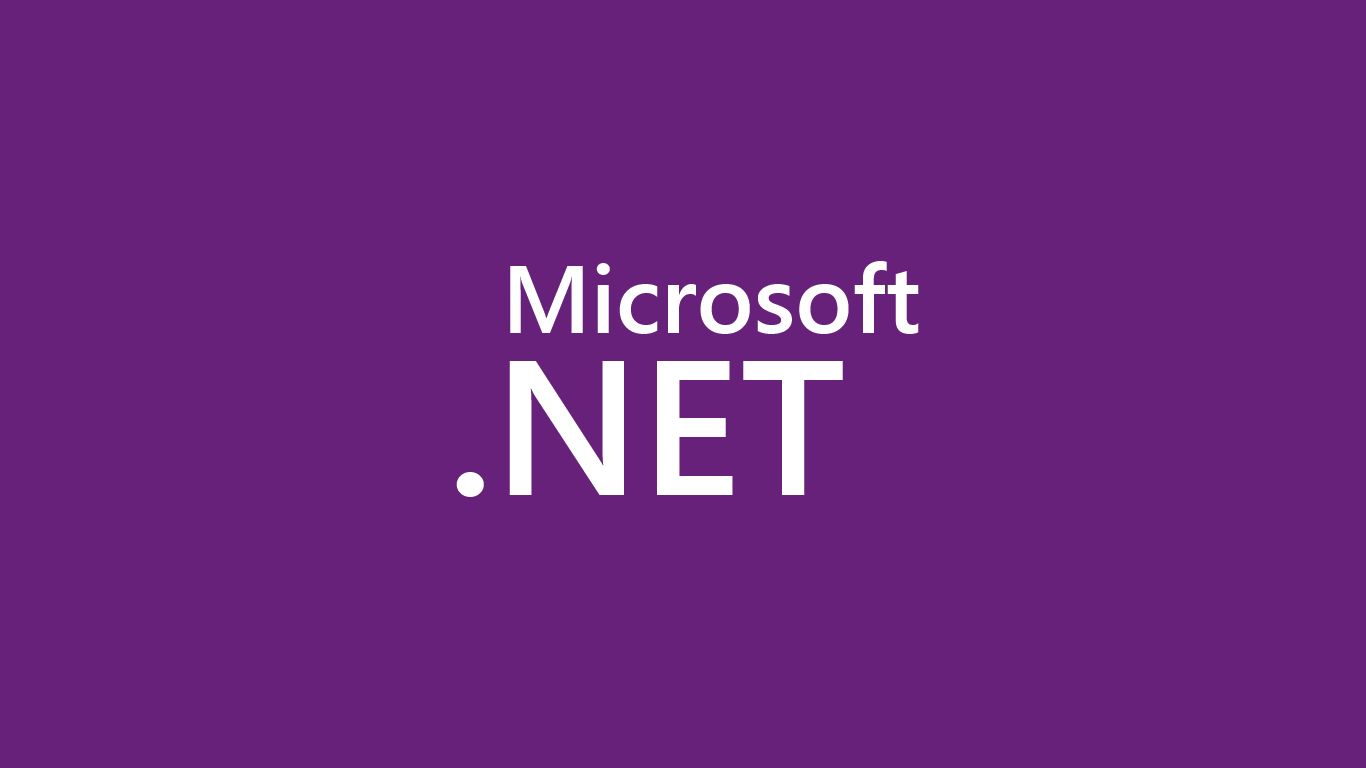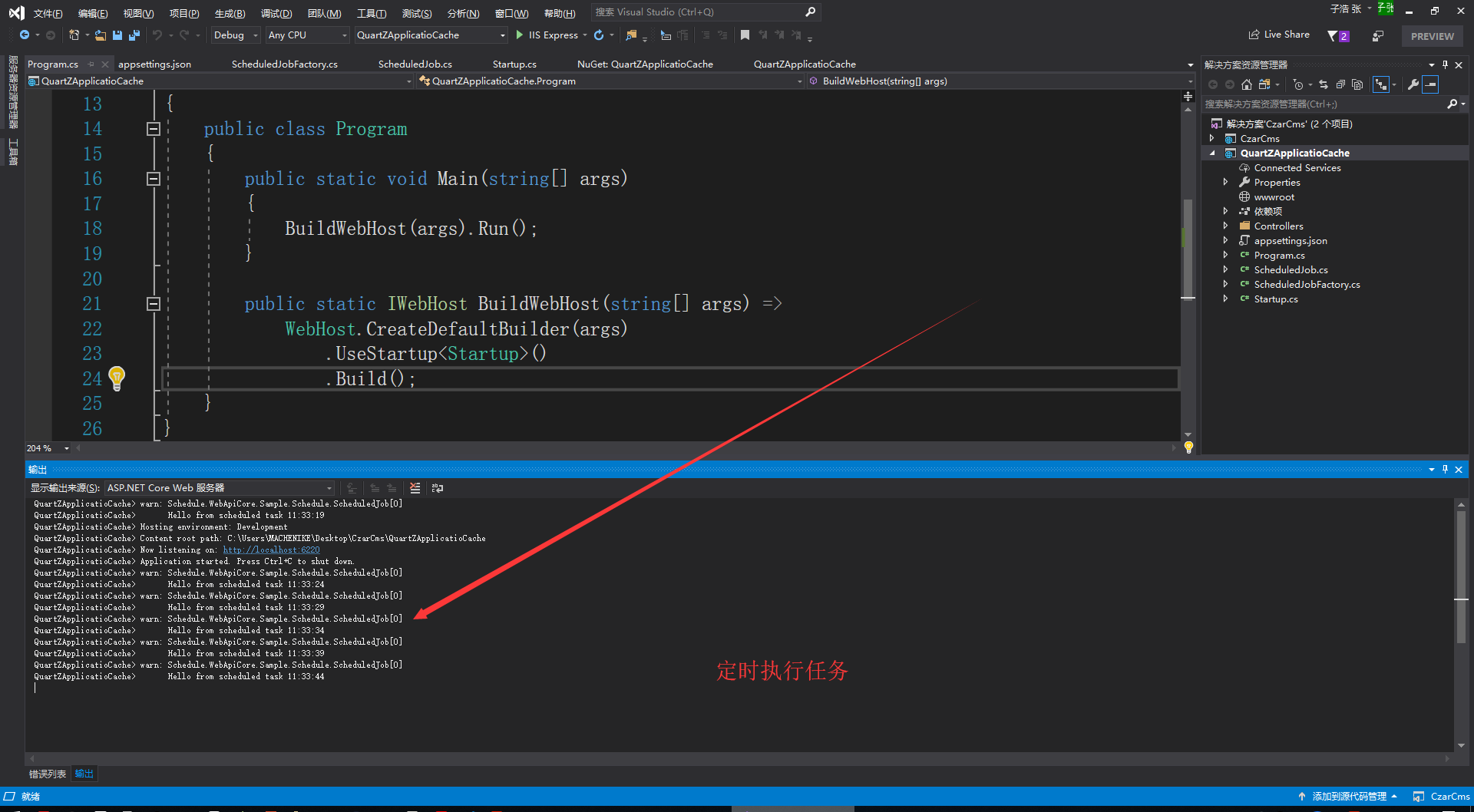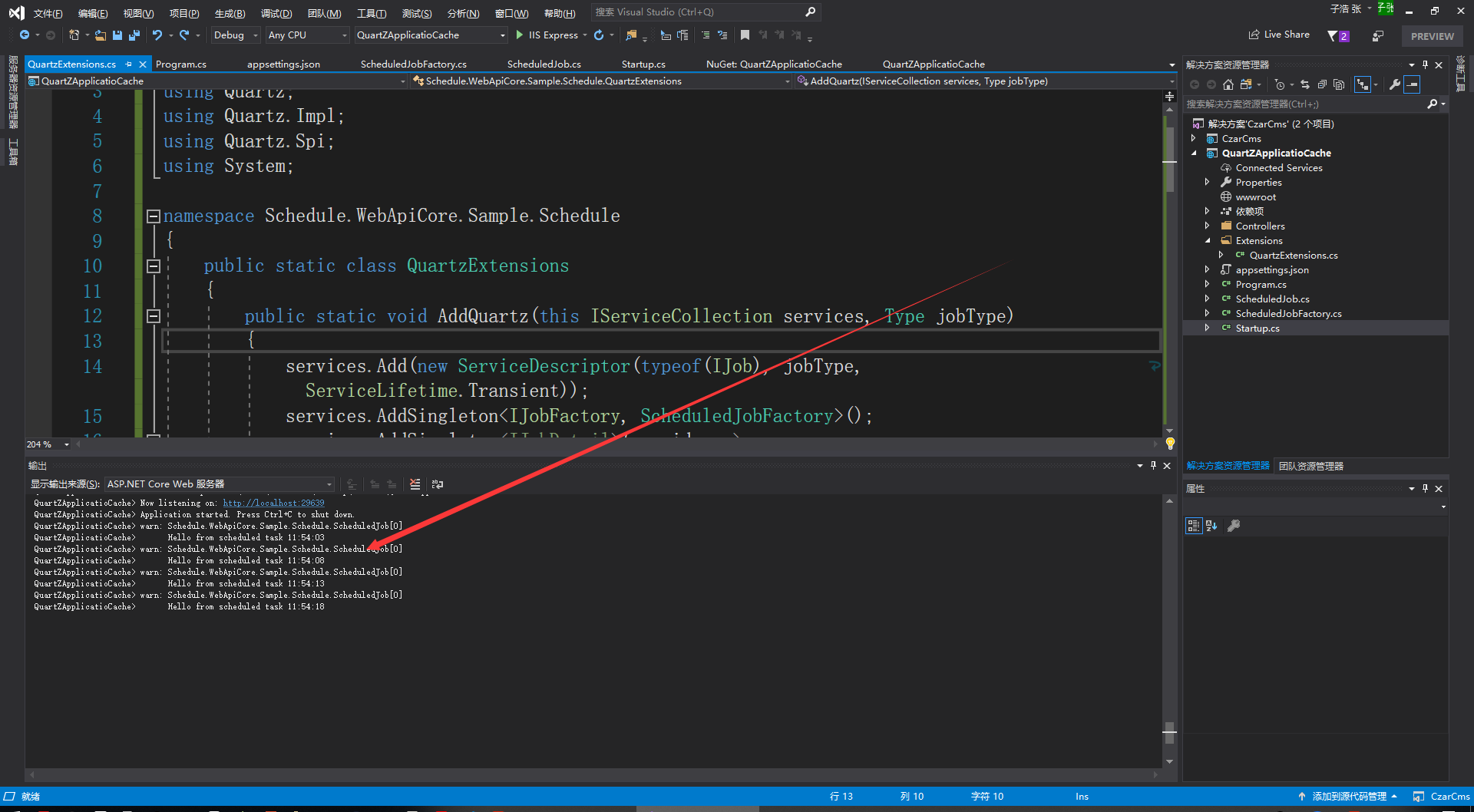ASP.NET Core MVC应用程序中的后台工作任务

在应用程序的内存中缓存常见数据(如查找)可以显着提高您的MVC Web应用程序性能和响应时间。当然,这些数据必须定期刷新。
当然你可以使用任何方法来更新数据,例如Redis中就提供了设定缓存对象的生命时间,那么对于这种单对象的更新的做法我觉得是不符合我的编程习惯的,我们可以使用QuartZ.NET 框架来进行任务调度,我们在任务计划中进行统一的缓存更新,也就达到了我们的目的。
Quartz受到良好支持,跨平台库可用于在应用程序内部调度任务。由于ASP.NET Core架构和开箱即用的中间件支持,在.NET Core MVC Web应用程序中使用它有点不同。在本文中,我将尝试使用ASP.NET核心应用程序中的Quartz来解释后台工作者计划任务的简单计划。
我使用简单的ASP.NET Core WebApi项目模板作为示例项目的基础。由于我们不会关注端点的实际响应,而是关注Startup.cs依赖注入部分和中间件,默认的WebApi项目模板就好了。
作为第一步我们应该引用Quartz框架,我将使用Nuget管理器,我现在使用的工具是Visual Studio 2019 体验版。
Install-Package Quartz -Version 3.0.7
如果你在Linux或Mac Os上进行开发,那么请安装.net core sdk 在使用.net 脚手架来进行引入。
dotnet add package Quartz --version 3.0.7
由于ASP.NET Core具有开箱即用的依赖注入支持,我们需要在启动时设置我们的解析器,但在我们这样做之前,我们需要编写我们将用于设置调度的一些Quartz接口的实现我们项目中的任务。
我们首先需要编写我们的任务,即将按特定时间表执行的代码单元。为此,我们需要在我们的作业类中实现 Quartz.IJob接口。
using Microsoft.Extensions.Configuration; using Microsoft.Extensions.Logging; using Quartz; using System; using System.Threading.Tasks; namespace Schedule.WebApiCore.Sample.Schedule { public class ScheduledJob : IJob { private readonly IConfiguration configuration; private readonly ILogger<ScheduledJob> logger; public ScheduledJob(IConfiguration configuration, ILogger<ScheduledJob> logger) { this.logger = logger; this.configuration = configuration; } public async Task Execute(IJobExecutionContext context) { this.logger.LogWarning($"Hello from scheduled task {DateTime.Now.ToLongTimeString()}"); await Task.CompletedTask; } } }
由于它只是一个示例应用程序,因此每次作业执行时,我只会在输出中写入当前时间的消息。将从Startup.cs类方法注入Microsoft.Extensions.Configuration.IConfiguration和Microsoft.Extensions.Logging.ILogger接口实现的实例
我们需要实现的下一个接口是Quartz.Spi.IjobFactory。
using Quartz; using Quartz.Spi; using System; namespace Schedule.WebApiCore.Sample.Schedule { public class ScheduledJobFactory : IJobFactory { private readonly IServiceProvider serviceProvider; public ScheduledJobFactory(IServiceProvider serviceProvider) { this.serviceProvider = serviceProvider; } public IJob NewJob(TriggerFiredBundle bundle, IScheduler scheduler) { return serviceProvider.GetService(typeof(IJob)) as IJob; } public void ReturnJob(IJob job) { var disposable = job as IDisposable; if (disposable != null) { disposable.Dispose(); } } } }
我们将IJobFactory接口实现的实例分配给我们的IScheduler实例,该实例将用于在每个调度触发器上实例化作业实例。现在在我们的Startup.cs中设置依赖注入解析器。
配置
using System; using System.IO; using Microsoft.AspNetCore.Builder; using Microsoft.AspNetCore.Hosting; using Microsoft.AspNetCore.Mvc; using Microsoft.Extensions.Configuration; using Microsoft.Extensions.DependencyInjection; using Quartz; using Quartz.Impl; using Quartz.Spi; using Schedule.WebApiCore.Sample.Schedule; namespace Schedule.WebApiCore.Sample { public class Startup { public IConfiguration Configuration { get; } public IHostingEnvironment HostingEnvironment { get; } public Startup(IConfiguration configuration, IHostingEnvironment hostingEnvironment) { this.HostingEnvironment = hostingEnvironment; this.Configuration = configuration; } public void ConfigureServices(IServiceCollection services) { services.AddLogging(); services.AddSingleton<IConfiguration>(new ConfigurationBuilder() .SetBasePath(Directory.GetCurrentDirectory()) .AddJsonFile("appsettings.json") .AddJsonFile($"appsettings.{this.HostingEnvironment.EnvironmentName.ToLower()}.json") .Build()); #region Configure Quartz DI services.Add(new ServiceDescriptor(typeof(IJob), typeof(ScheduledJob), ServiceLifetime.Transient)); services.AddSingleton<IJobFactory, ScheduledJobFactory>(); services.AddSingleton<IJobDetail>(provider => { return JobBuilder.Create<ScheduledJob>() .WithIdentity("Sample.job", "group1") .Build(); }); services.AddSingleton<ITrigger>(provider => { return TriggerBuilder.Create() .WithIdentity($"Sample.trigger", "group1") .StartNow() .WithSimpleSchedule (s => s.WithInterval(TimeSpan.FromSeconds(5)) .RepeatForever() ) .Build(); }); services.AddSingleton<IScheduler>(provider => { var schedulerFactory = new StdSchedulerFactory(); var scheduler = schedulerFactory.GetScheduler().Result; scheduler.JobFactory = provider.GetService<IJobFactory>(); scheduler.Start(); return scheduler; }); #endregion services.AddMvc(); } // This method gets called by the runtime. Use this method to configure the HTTP request pipeline. public void Configure(IApplicationBuilder app, IHostingEnvironment env, IScheduler scheduler) { if (env.IsDevelopment()) { app.UseDeveloperExceptionPage(); } scheduler.ScheduleJob(app.ApplicationServices.GetService<IJobDetail>(), app.ApplicationServices.GetService<ITrigger>()); app.UseMvc(); } } }

修改Startup.cs
启动项目没有什么问题~但当你将所有部件放在Startup.cs中的一个地方时,这样更容易解释整个DI设置,在那里你可以看到所有的依赖关系和接口是如何解决的,但是从长远来看,这个Startup.cs应该是凌乱的它最终将成为维持的噩梦。出于这个原因,我将整个DI包装到扩展方法中。
综上所述,我们的.Net Core为我们提供了解决方案,那么把Quartz的代码全部放到一个静态类中,它将使用Quartz的Microsoft依赖注入语句和管道的Microsoft.AspNetCore.Builder.IApplicationBuilder扩展 Microsoft.Extensions.DependencyInjection.IServiceCollection 。
就我个人而言,我喜欢在项目中创建一个Extensions文件夹,然后在其中写入类,再去Startup.cs中进行配置!QuartzExtensions定义如下:
public static class QuartzExtensions { public static void AddQuartz(this IServiceCollection services, Type jobType) { services.Add(new ServiceDescriptor(typeof(IJob), jobType, ServiceLifetime.Transient)); services.AddSingleton<IJobFactory, ScheduledJobFactory>(); services.AddSingleton<IJobDetail>(provider => { return JobBuilder.Create<ScheduledJob>() .WithIdentity("Sample.job", "group1") .Build(); }); services.AddSingleton<ITrigger>(provider => { return TriggerBuilder.Create() .WithIdentity($"Sample.trigger", "group1") .StartNow() .WithSimpleSchedule (s => s.WithInterval(TimeSpan.FromSeconds(5)) .RepeatForever() ) .Build(); }); services.AddSingleton<IScheduler>(provider => { var schedulerFactory = new StdSchedulerFactory(); var scheduler = schedulerFactory.GetScheduler().Result; scheduler.JobFactory = provider.GetService<IJobFactory>(); scheduler.Start(); return scheduler; }); } public static void UseQuartz(this IApplicationBuilder app) { app.ApplicationServices.GetService<IScheduler>() .ScheduleJob(app.ApplicationServices.GetService<IJobDetail>(), app.ApplicationServices.GetService<ITrigger>() ); } }
现在我们的Startup.cs更清洁,更容易维护和扩展!
public class Startup { public IConfiguration Configuration { get; } public IHostingEnvironment HostingEnvironment { get; } public Startup(IConfiguration configuration, IHostingEnvironment hostingEnvironment) { this.HostingEnvironment = hostingEnvironment; this.Configuration = configuration; } // This method gets called by the runtime. Use this method to add services to the container. public void ConfigureServices(IServiceCollection services) { services.AddLogging(); services.AddSingleton<IConfiguration>(new ConfigurationBuilder() .SetBasePath(Directory.GetCurrentDirectory()) .AddJsonFile("appsettings.json") .AddJsonFile($"appsettings.{this.HostingEnvironment.EnvironmentName.ToLower()}.json") .Build()); services.AddQuartz(typeof(ScheduledJob)); services.AddMvc(); } // This method gets called by the runtime. Use this method to configure the HTTP request pipeline. public void Configure(IApplicationBuilder app, IHostingEnvironment env) { if (env.IsDevelopment()) { app.UseDeveloperExceptionPage(); } app.UseQuartz(); app.UseMvc(); } }
再次启动项目,ok 通过~

祝.Net Core 越来越好!






【推荐】国内首个AI IDE,深度理解中文开发场景,立即下载体验Trae
【推荐】编程新体验,更懂你的AI,立即体验豆包MarsCode编程助手
【推荐】抖音旗下AI助手豆包,你的智能百科全书,全免费不限次数
【推荐】轻量又高性能的 SSH 工具 IShell:AI 加持,快人一步
· 从 HTTP 原因短语缺失研究 HTTP/2 和 HTTP/3 的设计差异
· AI与.NET技术实操系列:向量存储与相似性搜索在 .NET 中的实现
· 基于Microsoft.Extensions.AI核心库实现RAG应用
· Linux系列:如何用heaptrack跟踪.NET程序的非托管内存泄露
· 开发者必知的日志记录最佳实践
· TypeScript + Deepseek 打造卜卦网站:技术与玄学的结合
· Manus的开源复刻OpenManus初探
· AI 智能体引爆开源社区「GitHub 热点速览」
· C#/.NET/.NET Core技术前沿周刊 | 第 29 期(2025年3.1-3.9)
· 从HTTP原因短语缺失研究HTTP/2和HTTP/3的设计差异